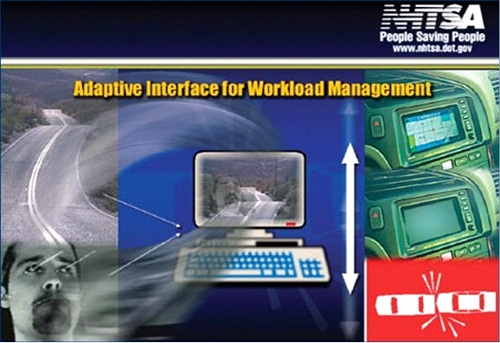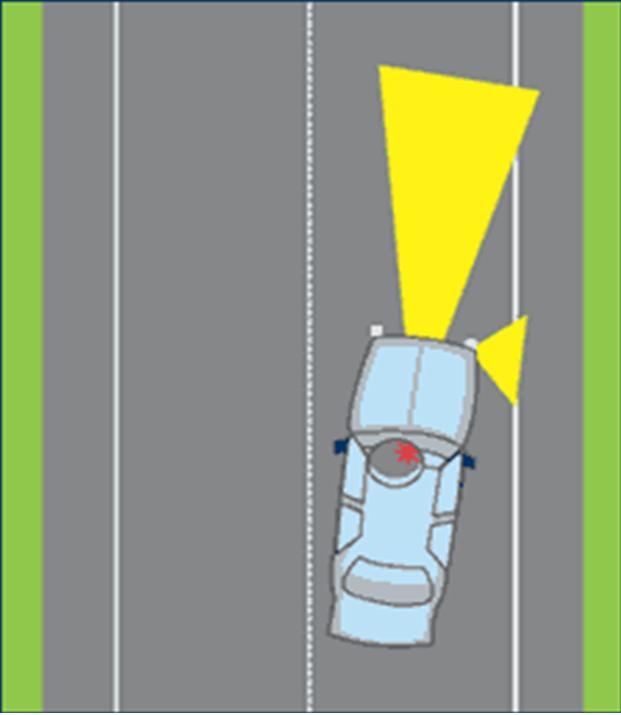Reducing Distraction-Related Automotive Crashes with SAVE-IT (NHTSA)
Excerpt from Volpe Center Highlights, Fall 2004.
Each year, distracted drivers cause up to 30 percent of the 6 million automotive crashes in the United States. Driver distraction has always been a safety issue, but as more complex controls, displays, communications devices, and entertainment systems appear in cars, the level of driver distraction is expected to increase. The National Highway Traffic Safety Administration (NHTSA) is directing a program that could help minimize the safety risk of distraction and improve the effectiveness of in-vehicle technologies.
Advanced Technologies Can Cause Information Overload
Today's drivers often deal with an onslaught of information that can divert their attention from their primary task of driving. In addition to observing and reacting to weather, road, vehicle, and traffic conditions, drivers may use technologies such as the following:
- Entertainment systems such as radios, CDs or MP3 players, or movie screens
- Telematic systems for navigation, email, cell phones, or traffic information
- Driver assistance systems such as cruise control or collision warning
Although some in-vehicle technologies are intended to improve safety, the use of multiple devices may distract the driver and actually jeopardize safety. When multi-tasking, drivers divert their attention from the road to glance at displays, operate controls, or listen and speak to a voice interface.
Vehicles in which electronic systems and devices are embedded or operated must be designed so that the demands on drivers match their capabilities to process and respond to safety-critical information. A promising approach being pursued by academic and industry researchers involves a central monitoring system that integrates data from in-vehicle technologies and controls the information flow to the driver through an adaptive driver-vehicle interface.

Drivers are being offered an expanding array of advanced technologies, but using multiple devices while driving can distract a driver and lead to a collision. Driver distraction is an issue of growing concern to the National Highway Transportation Safey Administration (NHTSA). Volpe is supporting NHTSA's advanced research program that will develop, demonstrate, and evaluate SAVE-IT, a prototype vehicle designed to manage driver workload and minimize adverse safety consequences of emerging technologies.
SAVE-IT Integrates Information to Manage Driver Workload
To determine what safety benefits such an integrated system might achieve, NHTSA is developing a test vehicle, SAVE-IT (the SAfety VEhicle using adaptive Interface Technology). Volpe manages the multi-year SAVE-IT program for NHTSA's Office of Vehicle Safety Research. Volpe also provides technical expertise and product evaluation.
The SAVE-IT mission is to demonstrate a viable proof-of-concept vehicle capable of reducing distraction-related crashes and enhancing the effectiveness of collision-warning systems. Phase 1 of the program—completed in spring 2004—involved extensive human factors research to determine driver distraction and workload measures as well as user acceptance of distraction mitigation and safety warnings, and the development of a rudimentary vehicle prototype. Phase 2 is underway, with the objectives of enhancing and evaluating the SAVE-IT prototype, further exploring and evaluating technologies to measure driver distraction, and developing decision rules to prioritize in-vehicle information demands on the driver. The prototype will be evaluated in simulated environments and in on-road testing.
The SAVE-IT prototype is envisioned as a system that can assess the driving environment, monitor the driver's workload and distraction level, and adapt the flow of information to the driver accordingly. In concept, sensors monitoring the roadway, nearby traffic, vehicle operation, and driver state could provide information to a system that "decides" how to adapt the vehicle based on the demands of the task relative to the distraction state of the driver.
Sharing Knowledge to Advance Adaptive Interface Technology
The development of adaptive interface technology presents substantial technical challenges. In keeping with its expertise in knowledge sharing and in support of the SAVE-IT program, Volpe organized a research workshop, bringing together experts who presented the major current efforts in adaptive interface development and to discuss the future of this emerging field. The "International Workshop on Progress and Future Directions of Adaptive Driver Assistance Research" was held on May 13 and 14, 2004, at DOT Headquarters in Washington, D.C. Workshop goals were to understand the prior research and obstacles encountered in developing adaptive driver assistance, describe the current research approaches, specify key human factors and system integration challenges, identify features that may need standardization, and recommend methods and metrics to evaluate the enhanced safety of adaptive interfaces.
Plenary discussions at the Adaptive Driver Assistance Research workshop addressed critical issues such as the following:
- Components of distraction that lead to safety risks, e.g., visual, mental preoccupation, physical demands
- Measurements needed to capture safety risks
- Whether measurement is required under all conditions
- When to intervene and what interventions can mitigate distraction
- Interval from detection to introduction of mitigation strategies
- Individual difference in acceptance, performance, and multi-tasking capability
- Standards to minimize driver confusion when using different adaptive interfaces
- Tradeoffs between safety, driver annoyance, and other acceptance costs
- Human factors research needed to understand influences on driver acceptance
- Evaluation of the safety benefits of a prototype
- Role of driver education in operation of adaptive systems
- The usability paradox: if a tool makes a task easier, drivers will use it, rely on it more, and possibly increase their exposure to risk


